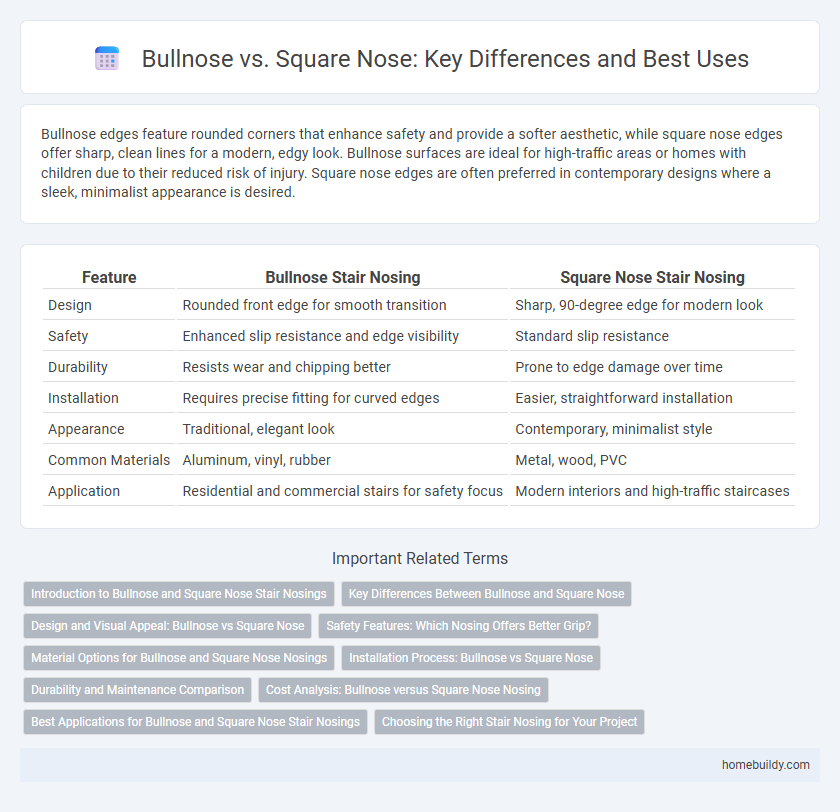Bullnose edges feature rounded corners that enhance safety and provide a softer aesthetic, while square nose edges offer sharp, clean lines for a modern, edgy look. Bullnose surfaces are ideal for high-traffic areas or homes with children due to their reduced risk of injury. Square nose edges are often preferred in contemporary designs where a sleek, minimalist appearance is desired.
Table of Comparison
| Feature | Bullnose Stair Nosing | Square Nose Stair Nosing |
|---|---|---|
| Design | Rounded front edge for smooth transition | Sharp, 90-degree edge for modern look |
| Safety | Enhanced slip resistance and edge visibility | Standard slip resistance |
| Durability | Resists wear and chipping better | Prone to edge damage over time |
| Installation | Requires precise fitting for curved edges | Easier, straightforward installation |
| Appearance | Traditional, elegant look | Contemporary, minimalist style |
| Common Materials | Aluminum, vinyl, rubber | Metal, wood, PVC |
| Application | Residential and commercial stairs for safety focus | Modern interiors and high-traffic staircases |
Introduction to Bullnose and Square Nose Stair Nosings
Bullnose stair nosings feature a rounded edge that enhances safety by reducing sharp corners and provides a smooth transition on staircases. Square nose stair nosings have a clean, angular edge that offers a modern aesthetic and precise fit on stair treads. Both types improve durability and slip resistance, with bullnose nosings commonly used for traditional designs and square nose nosings preferred in contemporary installations.
Key Differences Between Bullnose and Square Nose
Bullnose stair nosing features rounded edges that enhance safety by reducing sharp corners, making it ideal for high-traffic areas or where children and the elderly are present. Square nose stair nosing has sharp, angular edges that create a modern aesthetic and provide a flush finish with the stair tread, often preferred in contemporary designs. The key differences lie in their edge shapes, safety levels, and visual appeal, influencing both functionality and style in stair installations.
Design and Visual Appeal: Bullnose vs Square Nose
Bullnose stair nosing offers a rounded edge design that enhances visual appeal by providing a softer, more traditional look, often preferred in residential settings for its elegance and safety benefits. Square nose stair nosing features a sharp, clean edge that complements modern, minimalist interior designs by delivering a sleek and defined appearance. Choosing between bullnose and square nose depends on the desired aesthetic impact and the overall architectural style of the space.
Safety Features: Which Nosing Offers Better Grip?
Bullnose stair nosing offers enhanced safety features by providing a rounded edge that reduces the risk of tripping and improves foot traction on stair treads. Its curved design distributes weight evenly, minimizing pressure points and increasing grip, especially on high-traffic or slippery surfaces. In contrast, square nose stair nosing features a sharp, angular edge that may offer less slip resistance and can pose a greater risk of catching footwear, making bullnose a better choice for safety-focused stair installations.
Material Options for Bullnose and Square Nose Nosings
Bullnose stair nosings are commonly crafted from materials such as aluminum, vinyl, and rubber, offering a rounded edge that enhances safety and aesthetic appeal. Square nose nosings are typically available in durable materials including steel, PVC, and hardwood, providing a sharp, clean edge suited for modern design. Material selection influences durability, slip resistance, and compatibility with stair surfaces, making it essential to match the nosing type with specific functional needs.
Installation Process: Bullnose vs Square Nose
Bullnose stair nosing requires precise measurements and often involves cutting curved edges for a seamless fit, making the installation slightly more labor-intensive than square nose options. Square nose stair nosing offers straightforward installation with its clean, angular edges, allowing for easier alignment and quicker attachment using standard adhesives or fasteners. Both require surface preparation, but the bullnose demands careful attention to maintain its rounded profile during fitting.
Durability and Maintenance Comparison
Bullnose stair nosing features a rounded edge that provides enhanced impact resistance and reduces chipping, contributing to greater durability in high-traffic areas. Square nose stair nosing, with its sharp edge, may be more susceptible to damage and requires more frequent maintenance to prevent wear and tear. Maintenance for bullnose profiles typically involves less effort due to their smooth contours, whereas square nose profiles might need regular inspections and repairs to maintain safety and aesthetics.
Cost Analysis: Bullnose versus Square Nose Nosing
Bullnose stair nosing typically incurs higher costs due to its curved design requiring more material and specialized fabrication, whereas square nose nosing offers a more economical option with straightforward manufacturing. Installation expenses for bullnose can also be greater as precise alignment is crucial to maintain its rounded aesthetic, contrasting with the simpler installation process of square nose nosing. Long-term maintenance costs may favor bullnose nosing since its rounded edges reduce wear and trip hazards, potentially lowering future repair and liability expenses.
Best Applications for Bullnose and Square Nose Stair Nosings
Bullnose stair nosings are ideal for residential applications and high-traffic commercial spaces where safety and aesthetics are crucial, providing rounded edges that reduce trip hazards and enhance durability. Square nose stair nosings are best suited for industrial or modern architectural designs, offering a sleek, angular finish that accommodates heavy foot traffic and allows for easy installation on straight staircases. Both types improve stair safety by increasing slip resistance and protecting stair edges from wear and tear.
Choosing the Right Stair Nosing for Your Project
Choosing the right stair nosing between bullnose and square nose depends on the specific requirements of your project, including safety, aesthetics, and durability. Bullnose stair nosing features a rounded edge that enhances slip resistance and provides a softer visual appeal, ideal for residential and high-traffic areas. Square nose stair nosing offers a clean, modern look with a sharper edge, commonly used in commercial settings where durability and ease of installation are prioritized.
Bullnose vs Square nose Infographic

 homebuildy.com
homebuildy.com